Arm's New Cortex-A78 and Cortex-X1 Microarchitectures: An Efficiency and Performance Divergence
by Andrei Frumusanu on May 26, 2020 9:00 AM EST- Posted in
- SoCs
- CPUs
- Arm
- Smartphones
- Mobile
- GPUs
- Cortex
- Cortex A78
- Cortex X1
- Mali G78
Performance & Power Projections: Best of Both Worlds
We quickly looked at some projected figures at the start of the article, but now that we've had a chance to dig through the new CPUs, let's more precisely define the expected performance, power and area gains that the new Cortex-A78 and X1 cores are supposed to achieve.
Starting off with the Cortex-A78, the first comparison figures here are meant to represent the generational improvements the A78 would achieve in a target 2021 system on a TSMC N5 node. So the figures here contain both the microarchitectural gains as well as the expected process node improvements.
In terms of performance, at an ISO-power target of 1W for a core, Arm says that an A78 implementation would bring with it a 20% increase in performance, which is a healthy upgrade. A 2.6GHz A77 here on N7 here grossly matches the MediaTek Dimensity 1000(+), and the 1W power figure also roughly matches the power I’ve measured on that SoC.
Meanwhile at an ISO-performance comparison, the A78 would be able to halve the power and energy consumption compared to a 2.3GHz A77 on N7. This comparison is likely aimed at various mid-core implementations out there in the market, it is a bit of an arbitrary comparison but Arm also showcases some better figures we’ll go over in just a bit.
When actually looking at an ISO-process node comparison with a similar core configuration (essentially what Arm expects to be most commonly implemented), we’re seeing the A78 improve performance by roughly 7% over a Cortex-A77, all while reducing power by 4% and reducing area by 4%. It’s again important to note that while these figures sound maybe a little timid, Arm’s projected figures here do showcase an A78 with a lower-bounds configuration such as only 32KB L1D and L1I caches. I think the best way to interpret these numbers is to assume that this would be an implementation vendors would use to implement as their middle performance cores, leaving the higher perf targets for the X1.
Interestingly, Arm here for the first time ever published a whole performance/power curve of a microarchitecture, comparing the A77 to the A78. We see the higher cost at higher operating frequencies and the quadratic increase in power with increased voltage that is required to reach those higher frequencies (P = f * V²).
At the same peak performance point the A77 was able to achieve, the new A78 would use up 36% less power. At a more intermediate performance level (I think they might be using the process’ nominal voltage point here), this power reduction would be 30%. Finally, at the same power level, the A78 can increase performance by 7%.
Moving onto the Cortex-X1, the generational performance improvements here are a lot more impressive, and we’re seeing an increase of +30% in terms of peak performance at the same frequencies versus the A77. This comparison would actually be a maximally configured X1 versus a maximally configured A77. It's to be noted that we never saw a 3GHz A77 by vendors, meaning the real-world performance boost would actually be even bigger than this (I’m actually expecting vendors to finally hit that 3GHz target this time around, on 5nm, fingers crossed).
The 30% IPC improvements versus the A77 cover both integer and floating-point suites of SPEC2006, which is extremely impressive. Arm also showcased Stream bandwidth improvements as well as Octane performance boosts, although I don’t find these to be quite as relevant, although they do serve as pointers of what to expect of the microarchitectures in such workloads.
Arm was relatively vague on the power and area efficiency of the X1, quoting that they aren’t quite as public with these figures for these “custom” parts as they are with public roadmap designs such as the Cortex-A78, but I was able to figure out a few rough metrics. In terms of area, on a similar process, we should expect an X1 cores to be roughly 1.5x the size of an A78 – including the difference between maximized L1 and L2 caches. Power should also be roughly in that ballpark figure.
If vendors are able to actually do a good implementation and there aren't any bad surprises with the upcoming 5nm processes, we should be seeing something similar to these projections:
Again, as a big note – these figures are largely my own projections based on the various data-points that Arm has presented. This can end up differently in actual products, but in the past our predictions of the A76 and A77 ended up extremely close to the actual silicon, if not even pessimistically worse than what the real figures ended up at.
This generation, I do expect vendors to actually hit the 3GHz target for the Cortex-X1, as I have heard this being one of the goals the vendors are aiming to achieve for next year’s SoCs. I’m not too sure how many vendors will be doing for this for the Cortex-A78, which will more likely end up at lower clock speeds and implemented with a greater focus on power efficiency and area.
The Cortex-A78 would generally end up with the same power usage as current generation A77 products such as the Snapdragon 865 – with the vendors possibly using the process gains to get the last hundred MHz required to reach the 3GHz mark. The performance projection here is largely based on Arm’s +7% performance boost as well as a small clock boost. It would be a respectable upgrade, but nothing too earth-shattering in terms of generational updates.
The performance bump of an X1 system would be extremely competitive here, essentially being 37% faster than a Snapdragon 865 SoC today. That’s a huge generational bump and would put Arm very much in distance of Apple’s A13 cores, although in reality its competition would be the upcoming A14.
What’s really shocking here is how close Arm would be getting to Intel and AMD’s current best desktop systems in terms of performance. If both incumbent x86 vendors weren’t already worried about Arm’s yearly rate of improvement over the last few generations, they should outright panic at these figures if they actually materialize – and I do expect them to materialize.
The Cortex-X1 here is projected to use 1.5x the power of an A78. This might end up slightly lower but I’m being overly cautious here and prefer to be on the more pessimistic side. Here’s the real kicker though: the X1 could very well use up to 2x the power of a Cortex-A77/A78 and it would still be able to compete with Apple’s cores in terms of energy efficiency – the core’s increased performance largely makes up for its increased power draw, meaning its energy efficiency at the projected power would roughly only be 23% worse than an A78, and only 11-14% worse than say a current generation Snapdragon 865. Arm has such a big leeway in power efficiency at the moment that I just don’t see any scenario where the X1 would end up disappointing.
For years we’ve wanted Arm to finally go for no-compromise performance, and the Cortex-X1 is seemingly exactly that. That’s really exciting.


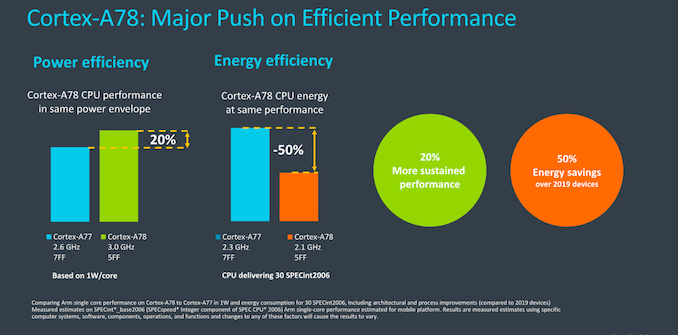
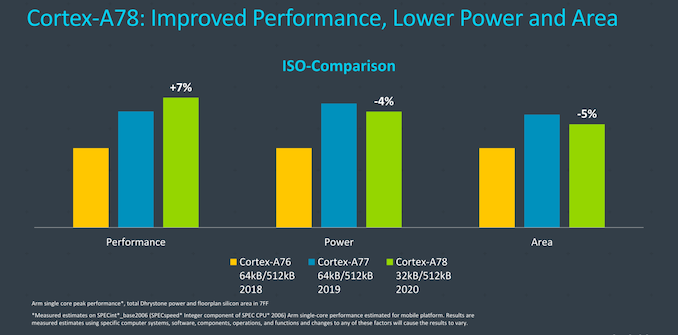

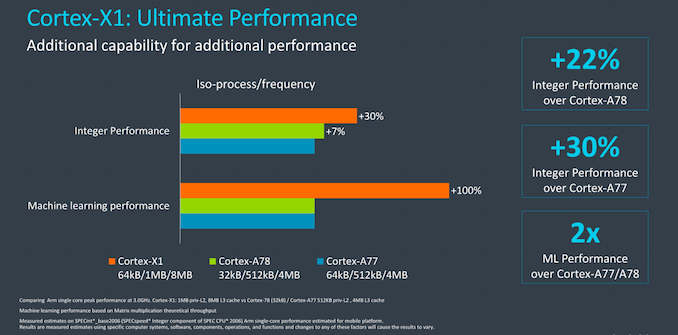
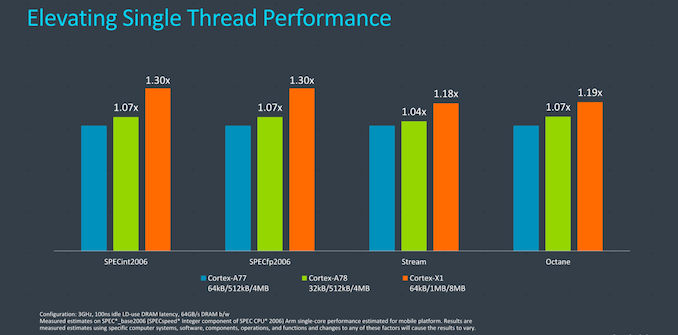
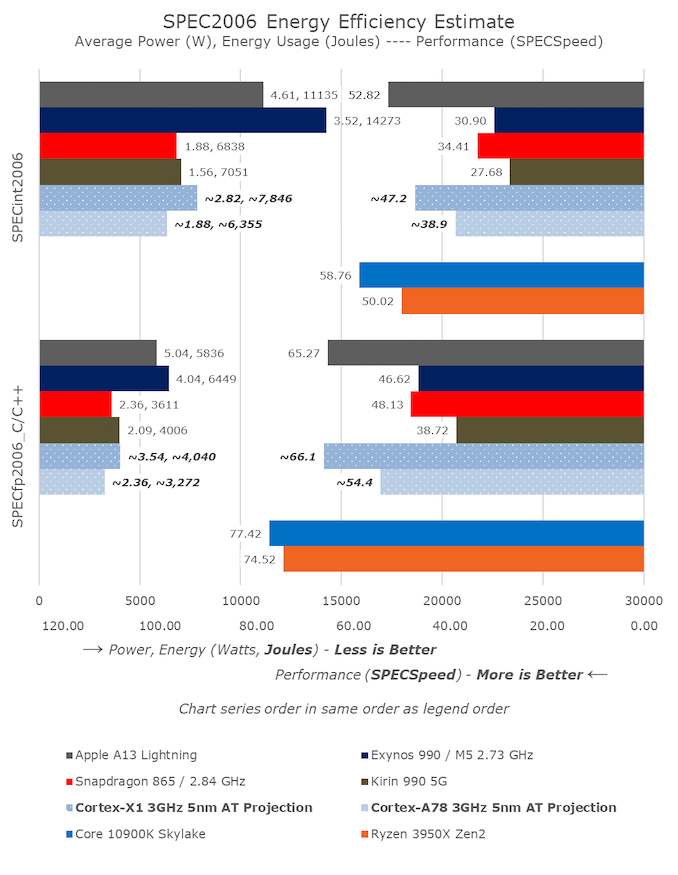








192 Comments
View All Comments
DanNeely - Tuesday, May 26, 2020 - link
having gotten to page 4 in the article, the explanation is that ARMs slides as used on the first page suck. The 20% from A77-A78 is +7% architecture, and +13% 5nm instead of 7nm. The 30% from A77-X1 is entirely architecture; that in turn implies that upcoming X1 chips should be about 40-45% faster than current A77 ones.AIUI It's still going to be falling short of what Apple's doing (and not just because the A55 little cores are getting really dated); but is a badly needed narrowing of the gap.
ichaya - Tuesday, May 26, 2020 - link
40-45% on appropriately less die area than Apple and you've got something competitive atleast.DanNeely - Tuesday, May 26, 2020 - link
in terms of engineering prowess certainly; but not in terms of letting Samsung/etc finally design smartphones and tablets that are as fast as their rivals from Apple. Assuming the product plays out in retail, in another 2 or 3 years when I look to replace my S10 I'll probably get something with an X core in it; but I really hope that they'll widen the performance uplift vs their more general purpose cores by then.Raqia - Tuesday, May 26, 2020 - link
The existing A77's are already very impressive in terms of PPA, I would consider them as impressive as Apple's big cores taken as a whole. (The small cores are another story since the major uplift from the A13...) A lot of Android vendors value area in particular since they integrate modems on die whereas Apple does not; this drives a lot of value and cost savings for customers.CiccioB - Tuesday, May 26, 2020 - link
If Samsung really wants to create a phone/tablet as fast as an Apple one it should first concentrate more on SW optimizations. Apple puts a lot of efforts in that. It's not only a question who makes the bigger core.See the comparison of Samsung crappy phones with other Android ones using much more optimized and less bloated version of the OS. They are good for benchmarking with all those cores and MHz (and tricks on turbo spped for benchmark apps), but in real life Samsung phones are slower than they could be do to low optimizations.
Wilco1 - Tuesday, May 26, 2020 - link
Bingo! Adding a big core that does well in benchmarks is not a good solution. Improving browser performance with software optimization can be far more effective.armchair_architect - Wednesday, May 27, 2020 - link
@Wilco1 I am afraid you only the SW part of the equation here.Again X1 is not only good in benchmarks, being wide helps in that you can achieve same performance as last-gen by running at vastly lower frequency and voltage.
Thus power efficiency for all use cases that do not require max peak perf enjoy a huge power saving.
Wilco1 - Thursday, May 28, 2020 - link
You can't brute-force your way to performance or efficiency. If you can improve performance via software optimization, you take it any time over a faster core that gives the same gain but needs more power to run the unoptimized software.It's as simple as that.
armchair_architect - Thursday, May 28, 2020 - link
Obviously you would ideally need both SW optimization and faster CPUs.But again, power will not always be higher and higher power != higher energy usage.
Wilco1 - Thursday, May 28, 2020 - link
Absolutely. But the biggest issue in the Android world is software optimization and tuning, not CPU performance. Improving that would easily add up to a new CPU generation. The choice to switch to LLVM was stupid at the time, but even more so today since GCC has since moved further ahead of LLVM...Note all the evidence points to using smaller cores to improve power efficiency. You can see this on the perf/W estimates for SPEC - the A78 is almost twice as efficient as A13 while achieving 74% of the performance.